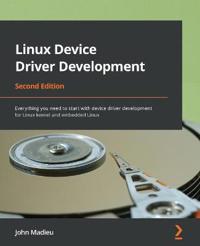
Linux Device Driver Development
Get up to speed with the most important concepts in driver development and focus on common embedded system requirements such as memory management, interrupt management, and locking mechanisms
Key Features- Write feature-rich and customized Linux device drivers for any character, SPI, and I2C device
- Develop a deep understanding of locking primitives, IRQ management, memory management, DMA, and so on
- Gain practical experience in the embedded side of Linux using GPIO, IIO, and input subsystems
Linux is by far the most-used kernel on embedded systems. Thanks to its subsystems, the Linux kernel supports almost all of the application fields in the industrial world. This updated second edition of Linux Device Driver Development is a comprehensive introduction to the Linux kernel world and the different subsystems that it is made of, and will be useful for embedded developers from any discipline.
You'll learn how to configure, tailor, and build the Linux kernel. Filled with real-world examples, the book covers each of the most-used subsystems in the embedded domains such as GPIO, direct memory access, interrupt management, and I2C/SPI device drivers. This book will show you how Linux abstracts each device from a hardware point of view and how a device is bound to its driver(s). You'll also see how interrupts are propagated in the system as the book covers the interrupt processing mechanisms in-depth and describes every kernel structure and API involved. This new edition also addresses how not to write device drivers using user space libraries for GPIO clients, I2C, and SPI drivers.
By the end of this Linux book, you'll be able to write device drivers for most of the embedded devices out there.
What you will learn- Download, configure, build, and tailor the Linux kernel
- Describe the hardware using a device tree
- Write feature-rich platform drivers and leverage I2C and SPI buses
- Get the most out of the new concurrency managed workqueue infrastructure
- Understand the Linux kernel timekeeping mechanism and use time-related APIs
- Use the regmap framework to factor the code and make it generic
- Offload CPU for memory copies using DMA
- Interact with the real world using GPIO, IIO, and input subsystems
This Linux OS book is for embedded system and embedded Linux enthusiasts/developers who want to get started with Linux kernel development and leverage its subsystems. Electronic hackers and hobbyists interested in Linux kernel development as well as anyone looking to interact with the platform using GPIO, IIO, and input subsystems will also find this book useful.
- Undertittel
- Everything you need to start with device driver development for Linux kernel and embedded Linux
- Forfatter
- John Madieu
- ISBN
- 9781803240060
- Språk
- Engelsk
- Vekt
- 310 gram
- Utgivelsesdato
- 11.3.2022
- Forlag
- PACKT PUBLISHING LIMITED
- Antall sider
- 708
